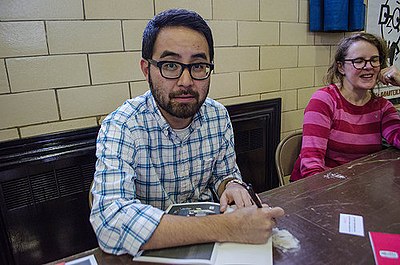Adrian Tomine
Adrian Tomine (born May 31, 1974), an American contemporary cartoonist. He is best known for his ongoing comic book series Optic Nerve and his illustrations in The New Yorker.[1]
| Adrian Tomine | |
|---|---|
Tomine at the 2014 Comic Arts Brooklyn | |
| Born | May 31, 1974 Sacramento, California, US |
| Nationality | American |
| Area(s) | Writer, Artist |
Notable works | Optic Nerve |
Early life
Adrian Tomine was born May 31, 1974, in Sacramento, California.[2] His parents divorced when he was two years old. His father is Dr. Chris Tomine, Ph.D. and Professor Emeritus Environmental Engineering at California State University Sacramento's Department of Civil Engineering. His mother is Dr. Satsuki Ina, Ph.D. and Professor Emeritus at California State University Sacramento's School of Education. Tomine is fourth-generation Japanese American, and both of his parents spent part of their childhoods in Japanese American internment camps in the U.S. during World War II.[3] He also has a brother, Dylan, who is eight years his senior.
After his parents divorced, Tomine moved frequently, accompanying his mother to Fresno, Oregon, Germany, and Belgium, while spending summers with his father in Sacramento. He started writing, drawing and self-publishing his comic Optic Nerve, which he has continued producing as a regular comic book series for Drawn & Quarterly.
As a young child, Tomine enjoyed Spider-Man and Indiana Jones comics. In an interview, Tomine said that "something about the medium just transfixed me at an early age"[4] and that his influences include Jaime Hernandez and Daniel Clowes. He is also a fan of contemporary Chris Ware. In addition to writing graphic novels such as Summer Blonde and Shortcomings,[5] Tomine regularly works in commercial illustration. He has done several covers and illustrations for The New Yorker; his first was "Missed Connection".
Career
Tomine began publishing his work when he was still a teenager; he was mainly self-published, but was also published in mainstream publications like Pulse! while still in high school. In an interview published in The Comics Journal #205, Tomine addressed criticisms of his work and discussed his influences in detail, admitting he was strongly influenced by Dan Clowes and Jaime Hernandez. The cover of his Journal issue featured a self-parody of sorts, featuring a sequence in which a hipster girl says to the reader, "I'm so cute! I love coffee, and indie rock! But... I'm sad. Can you relate?"
Optic Nerve is Tomine's ongoing comic series that was originally self-published in minicomic form and distributed to local comics shops in his area. Tomine published seven issues of the Optic Nerve mini; most of the stories from there were later compiled into a single edition, 32 Stories: The Complete Optic Nerve Mini-Comics, published by Drawn and Quarterly.
After Drawn and Quarterly became Tomine's publisher, Optic Nerve was published at standard comic book size, and the issue numbering was restarted, making the first Drawn & Quarterly published issue to be numbered #1. These comics range from a few pages per story to the 32-page standard in later issues. Issues #1-4 included several stories each and were collected in Sleepwalk and Other Stories, and issues #5-8 included one story each and were collected in Summer Blonde. Issues #9–11 were compiled into a graphic novel, Shortcomings, released in September 2007. In Shortcomings, Tomine explored racial issues directly.
In 2015, Tomine's graphic novel Killing and Dying, a collection of six short graphic stories, was released.[6]
Tomine has contributed his art to several albums, including liner notes and album art for Eels' Electro-Shock Blues, "Last Stop: This Town", "Cancer for the Cure", and End Times, also Yo La Tengo's album artwork that consisted solely of covers called Yo La Tengo Is Murdering the Classics and Murder in the Second Degree The Softies' album "It's Love", and The Crabs's "What Were Flames Now Smolder".
Collected works
- 1998 – 32 Stories: The Complete Optic Nerve Mini-Comics (ISBN 1-896597-00-9)
- 1998 – Sleepwalk and Other Stories (ISBN 1-896597-12-2)
- 2002 – Summer Blonde (ISBN 1-896597-57-2)
- 2004 – Scrapbook: Uncollected Work 1990-2004 (ISBN 1-896597-77-7)
- 2005 – New York Sketches 2004 (ISBN 0-9766848-2-9)
- 2007 – Shortcomings (ISBN 978-1-897299-16-6)
- 2011 – Scenes From an Impending Marriage (ISBN 978-1770460348)
- 2012 – New York Drawings (ISBN 978-1770460874)[1]
- 2015 – Killing and Dying (ISBN 978-1770462090)
- 2020 - The Loneliness of a Long-Distance Cartoonist (ISBN 978-1770463950)
References
- Kaneko, Mina (November 11, 2012). "Adrian Tomine's New York". The New Yorker.
- Adrian Tomine (2002). 32 Stories: The Complete Optic Nerve Mini-Comics. Drawn and Quarterly. p. 99. ISBN 9781896597003.
- Melissa Hung (Oct 16, 2002). "Geek Chic". East Bay Express. Retrieved 2006-09-17.
- Sinclair, Mark (March 13, 2009). "Q&A: Adrian Tomine". Creative Review. Archived from the original on 2015-03-19. Retrieved 2009-11-10.
- Windolf, Jim (November 11, 2007). "Asian Confusion". The New York Times.
- Rollman, Hans (20 October 2015). "In 'Killing and Dying', Drama Is Hidden Between the Lines of Profile Art and Dialogue". PopMatters.
External links
- Adrian Tomine's official website
- Tomine page at Drawn & Quarterly
- Tomine page at lambiek.net
- Nichi Bei Times interview
- Scene Missing Magazine interviews Adrian Tomine
- Hand-written interview with Adrian Tomine from ifpthendirt.
- Comics Reporter: Tom Spurgeon: A short interview with Adrian Tomine
- Adrian Tomine interview (December 2004) for QRD
- Review of Shortcomings @ The Culturatti
- Tomine interview (Jan 2008) Fresh Air, NPR
- 2011 radio interview (50 minutes) at The Bat Segundo Show
- "Interview with Adrian Tomine". The New Yorker. July 26, 2010.
- "Q&A with New Yorker Magazine about "Killing and Dying".The New Yorker. January 15, 2015.
